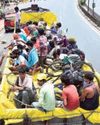
AS ON APRIL 20, TAMIL NADU RECORDED 1,520 positive COVID-19 cases, which included 33 children below the age of 10. Seventeen deaths were reported until April 20, which works out to a case fatality ratio (CFR) of 1.1 per cent against the national ratio of 3.34 per cent. As many as 457 persons who tested positive have recovered, for a recovery ratio of 30 per cent.
As on April 20, 2,10,538 passengers who came from overseas and other States were under home quarantine, of whom 1,07,103 persons were in 558 confinement zones and the rest at home. Some 47,710 persons had been tested. The highest number of tests in a day was 6,109 on April 20, of whom 43 were positive.
Calling the virus an “imported infection”, Chief Minister Edappadi K. Palaniswami claimed that due to sustained and dedicated efforts of the government, the infection ratio had started falling from its steep jump mainly from a “single source”. “In the past three days, i.e, from April 14 to April 16, we have been seeing less number of positive cases,” he said. He said confidently that in another four or five days the State would achieve “zero positive”.
His heightened optimism seems to have stemmed from an impressive list of details and statistics he was given and which he shared with the media on April 16. The Chief Minister told the media that his government had upped the ante against the virus from the last week of January itself on multiple fronts. It had stocked adequate quantity of medicines and emergency equipment. It had also augmented its health care infrastructure besides adding additional services such as isolation wards.
هذه القصة مأخوذة من طبعة May 08, 2020 من FRONTLINE.
ابدأ النسخة التجريبية المجانية من Magzter GOLD لمدة 7 أيام للوصول إلى آلاف القصص المتميزة المنسقة وأكثر من 9,000 مجلة وصحيفة.
بالفعل مشترك ? تسجيل الدخول
هذه القصة مأخوذة من طبعة May 08, 2020 من FRONTLINE.
ابدأ النسخة التجريبية المجانية من Magzter GOLD لمدة 7 أيام للوصول إلى آلاف القصص المتميزة المنسقة وأكثر من 9,000 مجلة وصحيفة.
بالفعل مشترك? تسجيل الدخول

How Not To Handle An Epidemic
The lockdowns were meant to buy time to put in place appropriate health measures and contain the coronavirus’ spread, but they have failed to achieve the objective and heaped immense misery on the marginalised sections of society. India is still in the exponential phase of the COVID-19 infection and community transmission is a reality that the government refuses to accept.

Tragedy on foot
As the COVID-19-induced lockdown cuts the ground beneath their feet in Tamil Nadu, thousands of migrant workers are trudging along the highway to the relative safety of their upcountry homes.

Sarpanchs as game changers
Odisha manages to keep COVID-19 well under control because of the strong participation of panchayati raj institutions and the community at the grass-roots level under the leadership of Chief Minister Naveen Patnaik.

Scapegoating China
As the COVID-19 death rate spikes and the economy tanks in the United States, Donald Trump and his advisers target China and the World Health Organisation with an eye to winning the forthcoming presidential election.

New worries
Kerala’s measured approach to the pandemic and lockdown has yielded results. But it still has to grapple with their huge economic impact on its economy, which it feels the Centre’s special financial relief package does little to alleviate.
No love lost for labour
Taking advantage of the lockdown and the inability of workers to organise protests, many State governments introduce sweeping changes to labour laws to the detriment of workers on the pretext of reviving production and boosting the economy.

Capital's Malthusian moment
In a world that needs substantial reorienting of production and distribution, Indian capital is resorting to a militant form of moribund neoliberalism to overcome its current crisis. In this pursuit of profit, it is ready and willing to throw into mortal peril millions whom it adjudicates as not worth their means—an admixture of social Darwinism born of capital’s avarice and brutalism spawned by Hindutva. .

Understanding migration
When governments and their plans are found to be blatantly wanting in addressing reverse migration, exercises such as the Ekta Parishad’s survey of migrant workers throughout India can be useful to work out creative long-lasting solutions.

Waiting for Jabalpur moment
The Supreme Court’s role in ensuring executive accountability during the ongoing lockdown leaves much to be desired. Standing in shining contrast is the record of some High Courts.

An empty package
The Modi regime, which has been unable to control the COVID-19 infection, restore economic activity and provide relief to millions exposed to starvation, trains its sights on Indian democracy, making use of the panic generated by fear and a lockdown that forecloses paths of resistance.